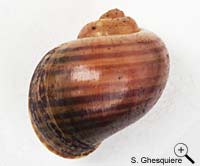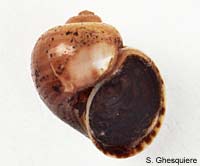(Spix, 1927)
(Spix, 1927)
|
The South American ampullarid Pomacea lineata is classified under the canaliculata complex. This is a groups af very closely related species which are very variable in size and appearance.
Shell: The shell of this apple snail
species is globose and relatively heavy (especially in older snails). The 5
to 6 whorls are separated by a indented suture, however less pronounced than
in Pomacea canaliculata. The shell opening (aperture) is large and oval
to round.
The size of these snails varies from 40 to 60 mm wide and 45 to 75 mm high depending
on the conditions.
The shell is brown with spiral bands. There is a lot of variation within the
species in shell shape as well in colour and banding pattern.
Operculum: The operculum is moderately thick and corneous. The structure
is concentric with the nucleus near the centre of the shell. The colour varies
light (in young snails) to dark brown. The operculum can be retracted in the
aperture (shell opening).
Body: The body has a grey-brownish colour with dark pigment spots.
 Pomacea lineata,
Repressa do Pitiaçu, Salvador, Bahia, Brasil. Pomacea lineata,
Repressa do Pitiaçu, Salvador, Bahia, Brasil. Collected from vegetation around lake, June 1994. |
 Pomacea lineata. Pomacea lineata. |
Reproduction:
Eggs: The pinkish eggs eggs are loosely attached to each other and are
deposited above the waterline. The average number of eggs within a single clutch
as around hundred eggs. The average size of the eggs is about 3mm diameter.
Near hatching the eggs become pink-whitish.
The colour of the eggs is probably the best method to differentiate Pomacea
lineata from Pomacea canaliculata,
as the latter has bright orange-pinskish eggs, while the former has pinkish
eggs. The difference is also observed in the albumen
gland, where the eggs are produced.
|
|
Food: Eats almost all types of vegetation.
Behaviour:
Habitat and distribution: The type species of Pomacea lineata is
well defined "Habitat in aquis Provinciae Bahiensis, e.g. in fluvio Itahype
(Almada river, Brasil)" (Spix, 1927). It's widely distributed in the province
of Bahia.
Looks similar to:
Not surprizingly Pomacea haustrum is very similar to other members of
the canaliculata
complex. For example, Pomacea lineata is very similar to Pomacea
canaliculata in external shape, internal
anatomy and habitat. Differences between these species are the colour of the
eggs and albumen gland (pinkish in Pomacea lineata,
while orange-reddish in Pomacea canaliculata)
and in the male reproductive apparatus. However, more research should be caried
out in form of microanatomic, biochemical and crossbreeding studies to have
a better understanding of the relation between these species.
Other Pomacea species that are very similar
to Pomacea lineata are Pomacea sordida
(Swainson, 1822) and Pomacea haustrum
(Reeve, 1856) (habitat: Manaron branche of the Amazon and Southern Bolivia)
and Pomacea insularum (D'Orbigny,
1839) (habitat: Parana, La Plata to Bolivia).
|
Except where otherwise noted, this page is licensed under a Creative Commons Attribution-NonCommercial-ShareAlike 2.5 License . http://www.applesnail.net |
|